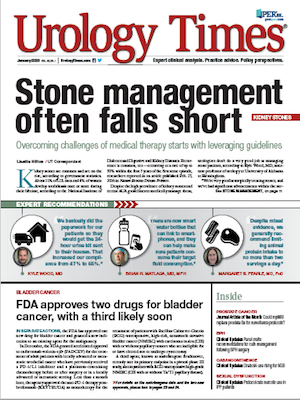Publication
Article
Urology Times Journal
Study of stone pain stresses personalized treatment
Author(s):
"This work is important to our field, because it represents an effort to personalize treatment approaches to particular patients’ needs," writes Brian R. Matlaga, MD, MPH.
Konstantin Yuganov - stock.adobe.com


Dr. Matlaga, a member of the Urology Times Editorial Council, is professor of urology at Johns Hopkins University School of Medicine, Baltimore.
Managing patient pain following stone treatment can be challenging. The genesis of the pain can be multifactorial, and often there is no single, curative agent that the treating urologist can rely on.
In recent years, our urologic community has recognized the drawbacks of relying on opioid agents to manage patient pain. The United States is currently suffering from an opioid epidemic. Although there are likely multiple factors responsible for this situation, physician prescribing patterns may be causative and can continue to exacerbate the problem.
Presently, discussions on pharmacologic management of patient pain are moving toward narcotic-free endoscopic stone procedures. At the same time, there is increasing interest in understanding the patient perception of treatment outcomes. Indeed, patient-reported metrics are an important factor that should be considered in defining a treatment’s success. In particular, when it comes to managing patient pain, the patient’s perspective is particularly relevant.
In this issue of Urology Times, a group from the University of North Carolina, under the direction of Dr. Davis Viprakasit, investigated how patients suffering from a symptomatic stone event evaluated their treatment outcomes. One of the areas of focus in this investigation was to identify differences in patient-reported outcomes between those who did or did not rank pain control as extremely important.
Pain-focused patients in the study required a larger reduction in symptoms to meet their outcome criteria for desired, expected, and success levels of pain symptoms. By contrast, patients who were not pain focused expected and were willing to accept lower levels of symptom improvement to consider their treatment successful. Patients who rated pain as their primary criteria for treatment success were significantly less likely to reach their expected outcome level for pain, and overall, those patients who were pain focused were less likely to meet their defined success criteria.
This work is important to our field, because it represents an effort to personalize treatment approaches to particular patients’ needs. As with all things in medicine, one size does not fit all. Although non-narcotic pain management should be our aspirational goal, it may not be feasible for every single patient that we treat. Pain management is a complex endeavor.
As urologists evolve our pain management strategies for stone patients, we must understand how patient biases and perceptions can affect the assessment of their treatment outcome. In this way, we will be able to develop novel interventions, be they in the domains of education, communication, or otherwise, which will allow pain to be managed and mitigated in a safe and effective manner.
Send your comments to Dr. Matlaga c/o Urology Times, at urology_times@mmhgroup.com































